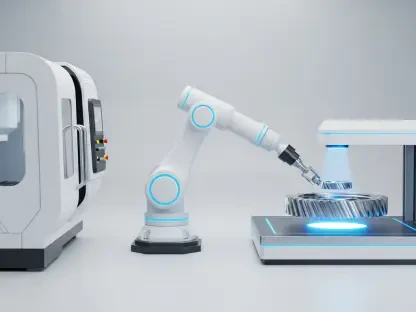The United States Material Testing Market is on the brink of a significant transformation, driven by technological advancements, regulatory changes, and evolving industry demands. This rapidly evolving industry is poised for substantial growth, encompassing key sectors such as manufacturing, construction, aerospace, and automotive. The push towards improved quality control, safety standards, and regulatory compliance is a substantial growth catalyst, prompting increased demand for advanced material testing equipment and services.
Technological Advancements in Material Testing
Technological innovation is a crucial factor contributing to the growth of the United States Material Testing Market. Advanced technologies like non-destructive testing (NDT) methods and automation are playing an essential role in ensuring product integrity and competitiveness within the U.S. market. Industries are increasingly adopting NDT techniques, such as ultrasonic testing, radiography, magnetic particle inspection, and eddy current testing, to evaluate material properties without causing damage to components.
These methods are particularly popular in aerospace, automotive, and infrastructure sectors for their efficiency and cost-effectiveness. By minimizing waste while maintaining high standards of quality control, NDT techniques are becoming indispensable. The adoption of these advanced testing methods ensures that products meet stringent safety and performance standards, which is critical in high-stakes industries. Moreover, the integration of automation with NDT methods is streamlining processes, enhancing consistency, and reducing manual errors, resulting in higher productivity and reliability in testing outcomes.
The rise of smart manufacturing further emphasizes the importance of technological advancements in material testing. Smart factories incorporate cutting-edge technologies and interconnected systems to optimize production processes. In this context, real-time monitoring and immediate feedback from material testing stages are crucial. The combination of NDT techniques and automation dovetails seamlessly with the ideals of smart manufacturing, aligning with broader industry trends towards digital transformation and improved operational agility. As industries continue to evolve and standards become more stringent, the role of technological innovation in material testing will only grow more significant, paving the way for the future of quality control.
Integration of Artificial Intelligence (AI) and Machine Learning (ML)
Another pivotal trend is the integration of artificial intelligence (AI) and machine learning (ML) into material testing processes. These technologies are revolutionizing the industry by automating data analysis, pattern recognition, and anomaly detection. AI and ML algorithms can process extensive datasets from various testing procedures to identify irregularities and predict potential material failures. This integration enhances both the speed and accuracy of testing while enabling predictive maintenance and early problem detection.
By significantly reducing downtime and maintenance costs, AI and ML are proving to be game-changers, particularly in the manufacturing sector, which demands real-time quality control. The potential of AI and ML in optimizing material testing processes is vast, offering a glimpse into the future of the industry. These technologies are not only transforming the speed and efficacy of testing but are also instrumental in advancing preventive maintenance strategies, thereby averting costly breakdowns and production halts. By enabling more intelligent decision-making through data-driven insights, AI and ML are setting new benchmarks in the material testing industry.
The benefits extend beyond manufacturing into diverse sectors such as aerospace, construction, and automotive, where the utmost reliability and safety are critical. AI-driven analytics can pinpoint subtle patterns and trends that human analysis might overlook, elevating the precision of material testing. Additionally, the continuous improvement capabilities of machine learning models enhance predictive maintenance, making equipment and processes more resilient over time. As AI and ML become more integrated, organizations can anticipate and address potential issues proactively, thus enhancing the overall quality and efficiency of their operations. This transformative application redefines the paradigm of material testing, making it more sophisticated and impactful.
Sustainability and Environmental Concerns
The growing emphasis on eco-friendly practices and products is influencing the United States Material Testing Market by driving the integration of sustainability into testing processes. Material testing now increasingly includes evaluating materials’ environmental impact, such as energy efficiency, recyclability, and carbon footprint. Testing services have evolved to measure and certify materials’ sustainability, addressing the demand for eco-conscious choices across multiple industries. With stringent regulations and shifting consumer preferences towards greener solutions, sustainability is set to remain a significant market trend. Companies are now more focused on developing sustainable materials and ensuring that their products meet environmental standards.
This shift towards sustainability is not only beneficial for the environment but also enhances the marketability of products in an increasingly eco-conscious market. Consumers and regulators are pushing for transparency in product manufacturing, compelling industries to invest in sustainable practices and certifications. Material testing procedures have adapted to these new demands by incorporating environmental criteria alongside traditional tests for strength and performance. Evaluating a material’s life cycle, from production to disposal, is becoming a standard part of the testing regimen, offering a comprehensive assessment of its environmental footprint and encouraging more responsible production methodologies.
In sectors such as construction and automotive, where sustainability is becoming a key differentiator, material testing services that emphasize eco-efficiency are gaining prominence. Companies are also exploring ways to reduce waste and energy consumption during testing processes, aligning with greener operations. The integration of sustainability into material testing is fostering innovation in developing environmentally friendly materials. By prioritizing eco-conscious testing procedures, the industry is playing a crucial role in promoting sustainability, thus contributing to a broader societal effort to reduce environmental impact and combat climate change. These efforts are setting a precedent for future market growth centered on responsible and sustainable practices.
Expansion of 3D Printing and Additive Manufacturing
The expansion of 3D printing and additive manufacturing technologies marks another major shift within the Material Testing Market. These technologies are proliferating in sectors such as healthcare, aerospace, and automotive, necessitating specialized testing procedures to cater to the unique requirements of 3D-printed components. Comprehensive material testing ensures the reliability, strength, and quality of parts produced through 3D printing. This trend is driving innovation in testing methodologies and equipment tailored to the specific demands of additive manufacturing.
As 3D printing continues to evolve, the need for rigorous testing to ensure the integrity of printed components becomes increasingly critical. This underscores a dynamic and evolving segment within the material testing market, highlighting the importance of staying ahead of technological advancements. In particular, 3D printing brings about unique challenges in dimensional accuracy, surface finish, and internal structure that conventional testing methods must adapt to address. Advanced testing techniques, such as CT scanning and in-situ monitoring, are emerging as essential tools to assess the quality and reliability of 3D-printed parts, ensuring they meet the required standards for their intended applications.
Manufacturers and testing service providers are collaborating to develop tailored testing protocols for different 3D printing technologies. As additive manufacturing matures, standardization of testing procedures across industries is becoming vital for consistent quality assurance. The ability to test and verify the performance of complex geometries and custom designs in 3D-printed components is crucial, especially in high-stakes fields like aerospace and medical devices, where precision and reliability are paramount. The continued expansion and integration of 3D printing into mainstream manufacturing are set to propel the demand for specialized material testing services, driving further advancements in testing equipment and methodologies crafted explicitly for additive manufacturing.
Digitalization and Data Management
Digitalization of material testing processes emerges as a transformative trend, with companies increasingly leveraging digital platforms and software solutions to streamline procedures and enhance data management. Digital tools enable the efficient recording, analysis, and reporting of test results, supporting remote monitoring and real-time access to insights. The importance of traceability and data integrity in industries such as construction and pharmaceuticals drives the adoption of these digital solutions. Ensuring that monitoring data is securely stored and readily accessible for compliance and quality control purposes is paramount.
This transformation towards digitalization facilitates transparency and data-driven decision-making, solidifying its role within the material testing market. By integrating digital systems into material testing workflows, companies can reduce human errors, enhance operational efficiency, and improve the accuracy of test results. Cloud-based solutions enable seamless data integration and sharing across different departments or even remote locations, fostering collaboration and accelerating the decision-making process. The ability to automatically generate detailed reports and maintain comprehensive digital records also aids in meeting regulatory requirements and facilitates audits, compliance checks, and certifications.
Furthermore, digitalization opens up opportunities for advanced data analytics, providing deeper insights into material performance and identifying trends that can inform future product development. With intelligent data management solutions, companies can store and analyze historical data, predict material behaviors, and optimize testing protocols. This contributes to continuous improvement and innovation in material testing procedures. As digital transformation progresses, the integration of Internet of Things (IoT) devices with testing equipment offers real-time monitoring and predictive maintenance capabilities, further enhancing the reliability and efficiency of material testing. Digitalization is clearly revolutionizing the industry, setting new standards for accuracy, efficiency, and interconnectivity in material testing processes.
Dominance of the Metal Segment
The metal segment continues to dominate the United States Material Testing Market, attributed to several factors, including its extensive use in industries like automotive, aerospace, construction, and manufacturing. These industries demand rigorous material testing of metal components to ensure performance and reliability, adhering to stringent quality and safety standards. Material testing evaluates metals’ mechanical properties, such as tensile strength, hardness, and impact resistance, which are crucial for critical applications.
Additionally, the construction sector depends on metal materials for structural purposes, necessitating thorough testing to assess their strength, load-bearing capacity, and corrosion resistance. The ongoing advancements in metal alloys and the rising demand for lightweight, high-performance materials ensure the metal segment’s continued market dominance. The shift towards advanced materials, such as high-strength steels and aluminum alloys, underscores the necessity for rigorous testing to validate these materials’ performance under various conditions. New testing methodologies are being developed to address the specific challenges posed by these advanced metals, ensuring their reliability and safety in critical applications.
In the automotive and aerospace sectors, the drive to enhance fuel efficiency and performance is leading to a greater focus on lightweight materials. This trend further amplifies the need for precise material testing to ensure that these lighter metals can withstand operational stresses without compromising safety. Innovations in testing techniques, such as fatigue testing and fracture mechanics, are crucial to assess the long-term durability and reliability of metal components used in these demanding environments. The dominance of the metal segment in material testing is a testament to its integral role in modern industry, ensuring that metal components meet the high standards required for safety, performance, and longevity.
Regional Insights: The Midwest’s Stronghold
The United States Material Testing Market is undergoing a critical transformation due to advancements in technology, changes in regulations, and shifting industry needs. This dynamic market is set for considerable growth, impacting key sectors like manufacturing, construction, aerospace, and automotive. The demand for better quality control, stringent safety standards, and regulatory compliance is serving as a major catalyst for this expansion. As a result, there is a growing call for advanced material testing equipment and services.
In the manufacturing sector, understanding the properties of materials ensures that products meet quality assurance before reaching consumers. In construction, materials must be tested rigorously to guarantee structural integrity and safety. For the aerospace industry, where safety is paramount, high standards for material testing are non-negotiable. And in the automotive sector, stringent testing can lead to innovations in safety and performance.
Furthermore, regulatory changes are increasingly stringent, pushing industries to adopt more sophisticated testing techniques. Companies are investing in cutting-edge technologies like automated testing systems, real-time data analysis, and non-destructive testing methods that can provide faster and more accurate results. This not only helps in adhering to compliance but also paves the way for innovations across various industries.
The overall trend points to a market that is not just growing but evolving. With a commitment to quality and safety, the United States Material Testing Market is poised to meet the challenges and demands of tomorrow’s industries.









